

7/2006
First wife-and-husband team so acknowledged

by Tracy Ostroff
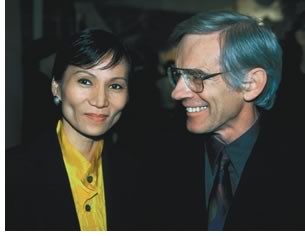 Acknowledging the work that is the life partnership of Craig Hodgetts, FAIA, and Hsin-Ming Fung, AIA, AIA Los Angeles awarded its Gold Medal—its highest honor—to the pair in June.
Acknowledging the work that is the life partnership of Craig Hodgetts, FAIA, and Hsin-Ming Fung, AIA, AIA Los Angeles awarded its Gold Medal—its highest honor—to the pair in June.
AIA/LA President William Fain, FAIA, honored the principals of Hodgetts + Fung Design for their commitment to creating a better Los Angeles. “Hodgetts and Fung are role models for their peers and for generations of designers to come,” Fain says. “It’s time the profession acknowledged that so much of architecture is the result of male-female teams.”
“It is really significant for us to be acknowledged both as individuals but also to acknowledge that our work is really about a partnership, not just as a couple, but as two people working together,” Fung says. “I believe most partnerships work in terms of complementing each other. The place we have achieved is to find a balance of complementing our differences as partners.”
“We’re proud to be the chapter to finally give the highest award to a husband-and-wife team,” says AIA/LA Executive Director Nicci Solomons. “We hope to right the wrongs that had led to so many female partners being ignored or marginalized in the past.”
Partners in all things
Hodgetts and Fung have been business partners for more than two decades. Their portfolio includes the new Hollywood Bowl, the UCLA Towell Library, Egyptian Theatre for American Cinematheque renovation, Yamano Tower in Tokyo, and the new Hyde Park Miriam Matthews Library in South Los Angeles. The practice is one of the architecture firms invited by Richard Meier, FAIA, to participate in the Houses of Sagaponac in Long Island. The firm has also created noted exhibitions, including the “Blueprints for Modern Living” exhibition on the Case Study Houses Program and “The Work of Charles and Ray Eames: A Legacy of Invention,” an international touring exhibition designed and co-curated for the Library of Congress and the Vitra Design Museum.
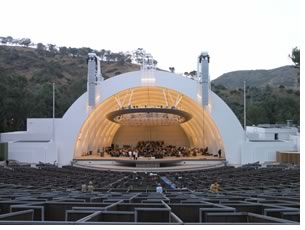 The pair has been married for about half the time they have practiced architecture together. “Initially, we just had a huge appetite for work. Then we were a couple. We always refer to ‘being partners in all things’ so that really, formalizing that with marriage, was less of a commitment than formalizing it as a business,” says Hodgetts.
The pair has been married for about half the time they have practiced architecture together. “Initially, we just had a huge appetite for work. Then we were a couple. We always refer to ‘being partners in all things’ so that really, formalizing that with marriage, was less of a commitment than formalizing it as a business,” says Hodgetts.
Their practice started with creating some of the very first computer ads. They also went on location to make some films, including a Roger Corman movie. “While our architecture commissions were pretty spotty, as they are when you are very young, we had a larger platform for exhibits and TV ads,” Hodgetts says. That led then to a very significant exhibit experience for us, which was the “Blueprints for Modern Living Exhibition” at the Museum of Contemporary Art here. The book is out on the catalogue, which really established the Case Study Program firmly in people’s minds. That was the turning point for our practice, where we began doing more architectural work.” Even at that time, Hodgetts says, they were not focused on one particular aspect of architecture and had a very broad scope. There was a large landscape project for the University of California for their Gateway, and, just one year following, a contemporary library for them.
The team says it is hard to characterize their practice. “Those projects still bracket our practice, which has historical aspects and very technologically demanding aspects. So it’s hard to categorize our practice, I think. It is just characterized by pure enthusiasm,” Hodgetts and Fung agree.
Partnership affects design, benefits clients
“One of the things that does characterize our work, in a way, and that of other couples, I’ve noticed is that work tends to be more nuanced, layered, and complex,” Hodgetts says. “Our own thought for why that is, is because as life partners you really, really have to work out your differences. You can’t stand on a corporate hierarchy. That impacts the design work to a very high degree. We found that where the iconic that would come from the Saarinens, Mies, and so forth in the past doesn’t seem to be possible as a couple. I truly think that’s because you can’t just leave work without resolving those issues when you’re really bound together by your whole life. It transcends the business relationship and really affects the design in a very profound and meaningful way.
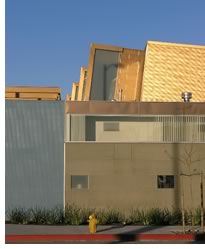 “That fluidity in terms of the client is fantastic because they get two points of view, but the points of view are not to triumph over one other, but to form a synthesis. That’s a very unusual thing and really benefits the project,” Hodgetts says.
“That fluidity in terms of the client is fantastic because they get two points of view, but the points of view are not to triumph over one other, but to form a synthesis. That’s a very unusual thing and really benefits the project,” Hodgetts says.
Hodgetts and Fung both say they have different styles and approaches to their design work. “I can say that I’m probably the one who dives into hot water and is the provocateur, so at the initiation of a project, I am generally the person who tests the boundaries and explores the spectrum,” Hodgetts says.
“And then I’m the person who tells him that he didn’t explore far enough,” Fung counters.
“Yes, that’s kind of true. And Ming is very sensitive to the nuances of the project and what might be appropriate. We run through many, many iterations where we explore that territory with one another until we arrive at a point that we feel really answers the mission of the project,” Hodgetts says. “If you were to scan through our portfolio, you would see that no two projects are anything similar to one another. That’s because that period of exploration is driven by both of us pushing one another as far as we can away from precedent and away from rehashing something we have done before. We really believe in the particularity of each project.”
Nuanced design
Hodgetts + Fung’s practice has always been eclectic and about exploration and innovation. “Very often a client will come to us to do a project for which we really do not have a track record. It’s only now, through almost 20 years of practice that we have a certain niche, whereas we’ve never had that niche before,” Fung says. Hodgetts notes the projects they enjoy the most—and those they are most likely to take on—are commissions that have dimension. “We like projects that have a cultural challenge to them, very often in an unchartered cultural terrain, very often with a technological twist.” What makes a project even more appealing, Hodgetts adds, is “when they are in very complex contexts so that dynamic between Ming and me really suggests ways to deal with all of those complexities.”
“As architects, our goal is to work on meaningful and relevant projects that challenge us to create unprecedented environments in response to the contemporary state of being,” Hodgetts says.
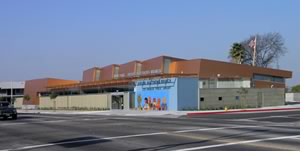 A project on the boards that has all those elements is a combined residential tower, beauty school for 2,000 students, and office in Tokyo. “It’s on an incredibly complicated site, which is complicated further by the Byzantine solar access laws in Tokyo and is made more complex because of the interaction of the three program elements. It was really critically important to empathize with the Japanese culture and aesthetic history and try to understand what the aesthetic mission might be,” Hodgetts explains.
A project on the boards that has all those elements is a combined residential tower, beauty school for 2,000 students, and office in Tokyo. “It’s on an incredibly complicated site, which is complicated further by the Byzantine solar access laws in Tokyo and is made more complex because of the interaction of the three program elements. It was really critically important to empathize with the Japanese culture and aesthetic history and try to understand what the aesthetic mission might be,” Hodgetts explains.
He further describes the program. “We all know the Japanese approach to architecture tends to be extremely tectonic, and our clients expressed to us that they felt that was not in keeping with their brand and with what they wanted to say in terms of that context. We approached the 30-story tower to find a more ‘feminine’ approach. That was a really intense dialogue, having to do with patterning and massing. That was the challenge that I don’t think we would have met so well if we hadn’t been a couple.”
More layers of design
“We’ve got a mom and dad shop here, and I think that’s a great thing. We were both really pleased that in a way we kind of blazed a trail here,” Fung adds to Hodgett’s sentiment. “We’re really honored to be the first couple to represent this award and make it possible for other partners. Because now it’s been acknowledged, and I think this is very significant in the field.”
“There are obviously other important partnerships in the past,” Hodgetts says; “not necessarily men and women, and the ones that you think of sometimes as ‘Corb and Charlotte’ and ‘Venturi and Denise.’ I think the people we emulate in our minds most are probably Charles and Ray Eames. Ming is shaking her head ‘no.’”
Fung says, “I actually don’t think so, because I don’t think that the way they work is similar to the way we work.”
Hodgetts considers that point: “Well, we can’t know how they actually worked, but from their work product there is an affinity.”
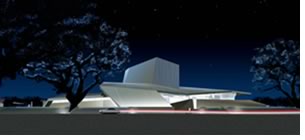 Hodgett’s and Fung’s commitment to architecture extends beyond traditional working hours. “It’s impossible not to take your work home with you. Interestingly, you begin to see that the trend of architects who are partners in life and work is growing much more because architecture is a field where it doesn’t stay in the office,” Fung offers. “Not just the work itself, but your whole social life revolves around architecture. If anything, these kinds of partnerships strengthen the relationship of people who are couples because they share a lot of values in common. Work and personal life become one because you really do immerse in your life as an architect. It’s actually easier because you can speak your mind any time of the day and your worries are shared. For us, it’s so much more helpful to bounce back and forth ideas or problems.”
Hodgett’s and Fung’s commitment to architecture extends beyond traditional working hours. “It’s impossible not to take your work home with you. Interestingly, you begin to see that the trend of architects who are partners in life and work is growing much more because architecture is a field where it doesn’t stay in the office,” Fung offers. “Not just the work itself, but your whole social life revolves around architecture. If anything, these kinds of partnerships strengthen the relationship of people who are couples because they share a lot of values in common. Work and personal life become one because you really do immerse in your life as an architect. It’s actually easier because you can speak your mind any time of the day and your worries are shared. For us, it’s so much more helpful to bounce back and forth ideas or problems.”
“We have a really complex relationship, Ming and I, because we’re not on the same page about an awful lot of things. But we both believe that individually we may not have all the answers.”
Hodgetts says the pair works to balance Fung’s sophistication with his impetuosity. “When I talk about the layers in our design it has to do with finding that balance. I think the kinds of clients we have appreciate that and are looking for that. Of course, that’s not every client. But we find that dynamic adds richness and experiential qualities to the projects that they might not otherwise have.”
Blazing a trail
Individually and together, Hodgetts and Fung always have done their own thing and they came to architecture via different paths. Hodgetts, a Midwesterner, came by way of automotive engineering and theater. “When we began our practice it wasn’t clear to us we were going to focus on architecture,” Hodgetts says.
“Yes,” Fung adds, “because I came from a fine arts background, so I was also interested in theater. I think theater was what brought Craig and me together.”
Hodgetts earned his bachelor’s degree in fine arts from Oberlin College. After college he nurtured his interest in theater and writing in San Francisco. Hodgetts enrolled at the University of California at Berkeley, then under the direction of Charles Moore. When Moore became the dean of the Yale architecture program in 1964, Hodgetts followed his mentor to New Haven, where he studied under the direction of James Stirling. “He opened my eyes to a radical, ingenious kind of architecture. It had to do with innovation, not replication,” Hodgetts says. “He showed me that architecture was an exhilarating, creative calling.” Hodgetts also teaches at UCLA.
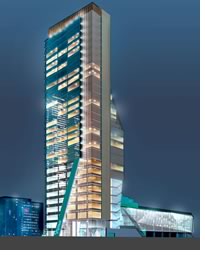 Fung, born outside the U.S., also came from a fine arts background—at Oxford College in Ohio. She received her MArch from the University of California at Los Angeles. Outside her practice, Fung has long pursued a range of architecture and academic endeavors. She is director of graduate programs at the Southern California Institute of Architecture (SCI-Arc). Under President Bill Clinton, she served as an appointee to the National Council on the Arts. Before joining SCI-Arc, she taught architecture at California State Polytechnic University for 16 years beginning in 1985, becoming a full professor in 1999. She’s also served as a visiting professor and critic at many prestigious art and architecture schools.
Fung, born outside the U.S., also came from a fine arts background—at Oxford College in Ohio. She received her MArch from the University of California at Los Angeles. Outside her practice, Fung has long pursued a range of architecture and academic endeavors. She is director of graduate programs at the Southern California Institute of Architecture (SCI-Arc). Under President Bill Clinton, she served as an appointee to the National Council on the Arts. Before joining SCI-Arc, she taught architecture at California State Polytechnic University for 16 years beginning in 1985, becoming a full professor in 1999. She’s also served as a visiting professor and critic at many prestigious art and architecture schools.
Hodgetts and Fung met through an architecture competition. “Ming was working at Charles Kober, and I had more or less dropped out and was trying to write screenplays and movies. I had done some work, which had come to her notice, and of course I was teaching at UCLA.” Fung adds, “I invited Craig to come on board to participate in a competition for the Olympic Housing in Korea. That’s how we began working together. Afterward Craig became interested in architecture again … And at that time he was dabbling with doing screenwriting. He was approached by the Cormans to remodel a house for them. Then he reciprocated the invitation and asked me if I was interested in working on that project with him. I left the firm to work on that project. Then we formed our own partnership out of a garage studio. We started with very small remodeling projects. It was kind of a natural evolution,” Fung recalls.
A larger voice
“And I had been through several partnerships prior to that, which is why I had decided I was going to hang up my hat and write movies,” Hodgetts says. “We designed a little roadside stand that got a Progressive Architecture Design Award. It was a lot of fun to do and that’s what really launched our practice.”
“I think the other aspect of this that brought us together in the first place was in 1984, especially when we started, Los Angeles was notable for having a very kind of diffused architectural culture. Ming and I, because we were both teaching, and because we both had interests in trying to communicate some of the larger issues to the general public, we found that together we had a larger voice. We both had these interests in exhibits and film, besides architecture, and so we were able to find a place in the architectural culture where we were beginning to broadcast the more important things. Again, like Ming was talking about, we had complementary skills that helped us do that in different directions.”
Hodgetts says, “The city is so diffuse that you really need to live it. You can’t have a 9-to-5 life in Los Angeles and have any impact. It was fortuitous that because we lived together, we could actually do that.”
Copyright 2006 The American Institute of Architects.
All rights reserved. Home Page ![]()
![]()
All images courtesy of the architect.
![]()